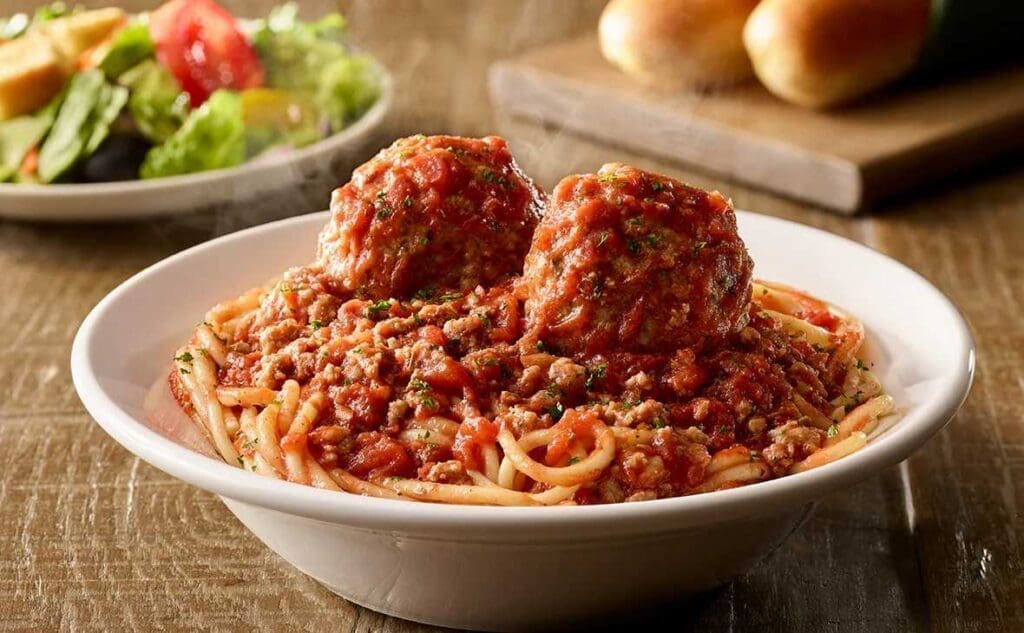The Nutritional Facts for Spaghetti and Meatballs
Spaghetti and meatballs is a cherished dish that offers various nutritional components based on the recipe and serving size. Here’s a thorough examination of the nutritional breakdown for a standard serving:
Overall Nutritional Facts for Spaghetti and Meatballs
- Calories: Approximately 700-900 kcal per serving. This range can vary based on the size of the serving and the specific ingredients used.
- Protein: 25-35 grams per serving. The protein content largely comes from the meatballs, which may be made from beef, pork, chicken, or a combination.
- Fat: 35 grams per serving. This includes fats from the meatballs, any added oil, and cheese. The amount can vary based on the fat content of the meat used and additional ingredients.
- Carbohydrates: 80-100 grams per serving. Most of these carbohydrates come from the pasta.
- Sodium: 800-1,200 milligrams per serving. The sodium content can vary significantly based on the amount of salt used in the meatballs and sauce.
- Fiber: 5-8 grams per serving. Fiber mainly comes from the pasta and tomato sauce.
Nutritional Value of Spaghetti Alone
- Calories: 140-200 kcal per cup of cooked spaghetti. This caloric value can differ slightly based on the brand and type of pasta.
- Protein: 7-8 grams per cup. Spaghetti itself is not a high source of protein but contributes a modest amount.
- Carbohydrates: 40-45 grams per cup. Spaghetti is a major source of carbohydrates in this dish.
- Fiber:
- Whole-Wheat Spaghetti: Contains 5-7 grams of fiber per cup. Whole-wheat pasta offers a higher fiber content compared to regular pasta.
- Regular Spaghetti: Contains 2-3 grams of fiber per cup.
- Fat: Less than 2 grams per cup. Spaghetti is naturally low in fat.
Spaghetti and Meatballs is a hearty and filling meal with a significant amount of calories, protein, and carbohydrates. The dish can be quite high in fat and sodium, depending on how it is prepared, but it provides a decent amount of fiber, especially if whole-wheat pasta is used. If you’re watching your intake of calories, fats, or sodium, you might want to consider portion sizes and ingredient choices carefully. For a more balanced meal, you might also pair this dish with a side of vegetables or a salad.


Frequently Asked Question (FAQs):-
1. What is the nutritional value of a serving of spaghetti and meatballs?
A. A serving provides approximately 700-900 calories, 25-35 grams of protein, 25-35 grams of fat, and 80-100 grams of carbohydrates.
2. How many calories are in homemade spaghetti and meatballs?
A. Homemade spaghetti and meatballs typically contain 700-900 calories per serving.
3. How much protein is in spaghetti and meatballs?
A. Spaghetti and meatballs generally provide 25-35 grams of protein per serving.
4. How much sodium is in spaghetti and meatballs?
A. The sodium content ranges from 800-1,200 milligrams, depending on the recipe.
5. Are Nutritional Facts for Spaghetti and Meatballs has high in fat?
A. Yes, this dish contains 25-35 grams of fat, with a portion coming from the meat and any added cheese or oil.
6. How much carbs in Nutritional Facts for Spaghetti and Meatballs?
A. The carbohydrate content is around 80-100 grams per serving.
7. Is spaghetti with meat sauce healthier than spaghetti with meatballs? Spaghetti and Meat Sauce calories:
A. Spaghetti with meat sauce generally has fewer calories and fat than spaghetti with meatballs, making it a slightly healthier option.
8. What is the nutritional value of just the spaghetti?
A. One cup of cooked spaghetti contains about 200-220 calories, 7-8 grams of protein, and 40-45 grams of carbohydrates.
9. How can I make spaghetti and meatballs healthier?
A. You can use whole-wheat pasta, lean meat for the meatballs, and a low-sodium sauce to reduce calories, fat, and sodium content.
10. What is the nutritional value of a full spaghetti dinner?
A. A full spaghetti dinner, including sides like garlic bread and salad, can range from 800-1,200 calories, with 30-40 grams of protein and 100-120 grams of carbohydrates.
Nutritional Facts for Spaghetti and Meatballs is another meal which is very rich but has a potential of being very unhealthy depending on the way it is prepared. Being a good source of protein it is been fastened with calories, fat and sodium hence should be taken in reasonable proportions or a better spice is used.





0 Comments